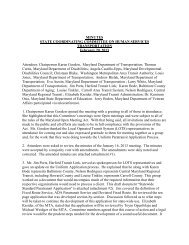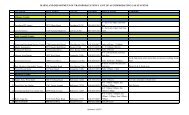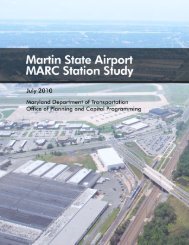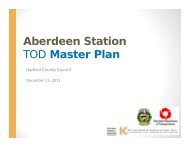PB PlaceMaking - Maryland Department of Transportation
PB PlaceMaking - Maryland Department of Transportation
PB PlaceMaking - Maryland Department of Transportation
Create successful ePaper yourself
Turn your PDF publications into a flip-book with our unique Google optimized e-Paper software.
Feasibility Analysis and<br />
Economic Benefit<br />
Key Findings<br />
The proposed development program exceeds $1 billion over four<br />
phases, and creates approximately:<br />
• 1.1 million square feet <strong>of</strong> new or rehabbed <strong>of</strong>fice space (with<br />
approximately half <strong>of</strong> that consisting <strong>of</strong> continued tenancy by<br />
State agencies).<br />
• 630,000 square feet <strong>of</strong> new retail and entertainment uses, including<br />
a new 200-room hotel.<br />
• 3,200 new residential units that include townhouses, condominiums,<br />
and apartments, with 10 percent <strong>of</strong> new units, excluding<br />
the McCulloh Homes site, at below-market rates.<br />
The Strategy calls for McCulloh Homes to be redeveloped to better<br />
meet the needs <strong>of</strong> its residents and enhance new residential and commercial<br />
development on adjacent blocks. McCulloh Homes would<br />
become a mixed-income, mixed-tenure community, with units for residents<br />
who wish to remain.<br />
• Approximately 100 units <strong>of</strong> the new or renovated rowhouses<br />
already planned by the City for the Upton neighborhood would<br />
be made available to interested McCulloh Homes residents.<br />
There is an approximately $81 million feasibility gap for all four<br />
phases. Public financing sources are needed to close this gap and<br />
make new development possible. The feasibility gap is primarily due<br />
to the high costs associated with redevelopment <strong>of</strong> McCulloh Homes<br />
and its replacement housing.<br />
• Redevelopment <strong>of</strong> State-owned property is feasible overall as<br />
well in each <strong>of</strong> the phases, except for the first phase that has a<br />
$4.2 million gap due to up-front infrastructure costs.<br />
New development, and adding State- and HABC-owned property to<br />
the property tax rolls, means that it is feasible to finance $81 million<br />
in Tax Increment Finance (TIF) bonds to close the feasibility gap, while<br />
still generating close to $10 million in additional annual property tax<br />
revenues for the City.<br />
State Center Transit Oriented Development Strategy 41









